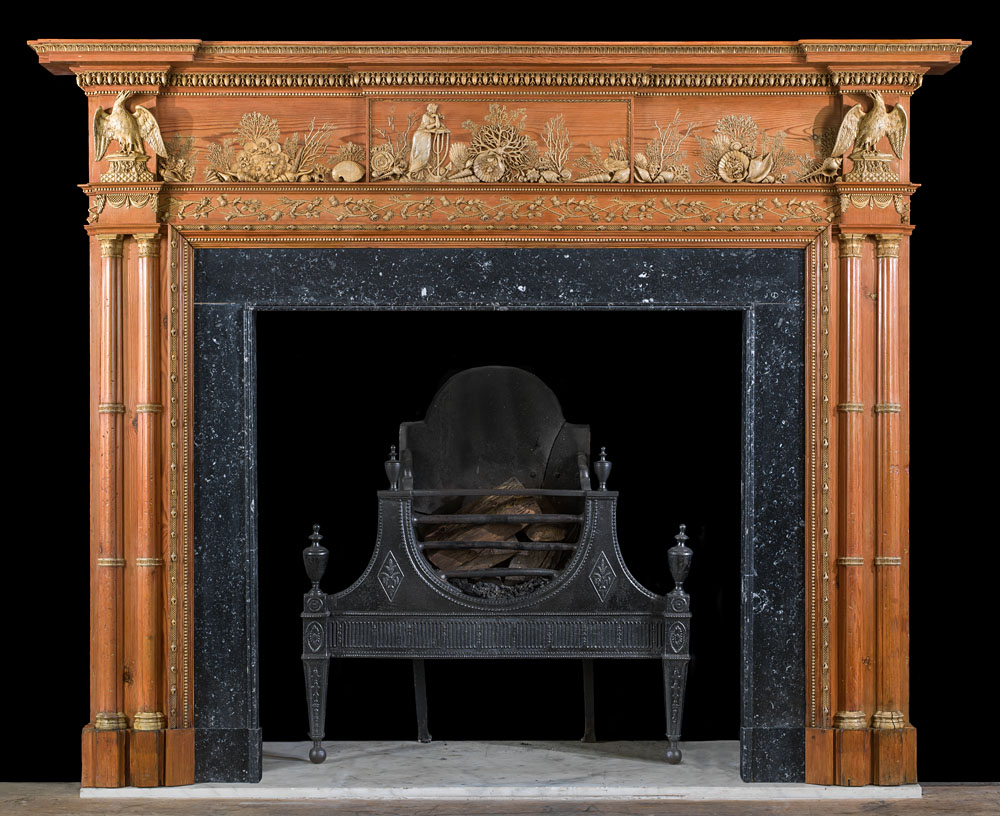

Stock No: 15547
A rare Scottish pine and composition chimneypiece by Richard Foster of Edinburgh.
The chimneypiece was designed with the coastal landscape of the East Coast of Scotland in mind and is profusely decorated in exquisite detail whilst maintaining the elegant restraint of a neoclassical chimneypiece.
The breakfront shelf rests above an undershelf studded with acorns and mushrooms which in turn is supported by two eagles on the endblocks. The eagles are modelled after a Roman Imperial Eagle in Horace Walpole’s collection, found in the gardens of Boccapadugli and displayed by Walpole at his Strawberry Hill Home. These details frame the remarkable frieze which is a celebration of the Scottish coast; profusely decorated with seaweed, shells, sea cucumber and crabs, all in high relief.
Most remarkable of all is the exquisite central tablet, which depicts Lady Emma Hamilton leaning on a ship’s anchor whilst gazing out to sea at the distant HMS Victory, the ship on which he would meet his heroic end. This scene is surrounded by a profusion of seashells and seaweed.
The underfrieze makes a departure from the coastal theme, and instead entwines thorny roses with the Scottish emblem of the thistle.
The jambs return to a more restrained neoclassicism, with engaged slender pilasters resting on plain footblocks. The original Kilkenny fossil marble slips are still present, which is a lovely feature.
Scottish, c.1805.
Provenance: Removed from an elegant Georgian house on the East Coast of Scotland, near Edinburgh.
Notes:
Chimneypieces of this manufacture were a speciality of Richard Foster of Edinburgh and his son and examples survive not only in Scotland but also in the United States and Canada, where he seemed to create a strong market for them in the late 18th century.
Richard Foster was born in Canonbie, the Scottish Borders, in 1755. At the age of fourteen, he was recorded as having a bank account in London, presumably as he was serving as an apprentice there, perhaps to the Adam Brothers as they too were in London at this time. In 1785 he returned to Edinburgh, working as a "joiner" and married to the daughter of a wealthy leather merchant. His chimneypieces were sold not only in Scotland, but in the USA, a bold move only a few years after American Independence was declared! This is perhaps why he avoided becoming a prominent figure in Scottish social and intellectual circles, as selling to Britain's former colonies would have been regarded as treachery in many cases.
The pine and composition chimneypiece he perfected made the rational principles and beauty of classicism affordable to the growing mercantile and professional class emerging in the 18th century. These clients wished to express their cultural understanding through objects that conveyed the principles they admired, the chimneypiece was one such highly prized object.
The Adam brothers (Robert and James) were well known for promoting their designs to the masses, and it is the pine and composition chimneypiece they made for the emerging middle class in Edinburgh that have become synonymous with the "Adam Style". However, Foster was a true master of the technique, and his designs are some of the most delicate and finely manufactured ever made.
In the 1770s, the technique of applying a cast composition onto pine really took off in Scotland, especially with the construction of many new houses, such as those in Edinburgh's New Town. The process of cast composition can be described as essentially a thermo plastic mix of chalk, glue size, and other additives heated up to a precise temperature then pressed into wood or brimstone moulds. These could then be applied to a simple pine surround and painted if desired. Foster was commissioned to make designs unique to clients, so there may only be a single example of a particular design, but these usually incorporate existing decorative motifs.
View our section showing full range of neo-classical chimneypieces
| Width | Height | Depth | |
|---|---|---|---|
| External | 78 13⁄16" 200.1 cms |
62 5⁄8" 159 cms |
7 7⁄8" 20.1 cms |
| Internal | 52" 132 cms |
45 1⁄4" 115 cms |